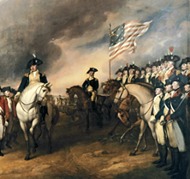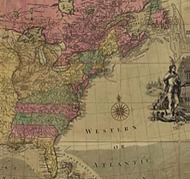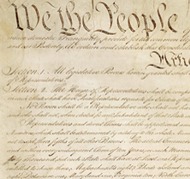—historical documents, literary texts, and works of art—
thematically organized with notes and discussion questions.
MAKING THE REVOLUTION presents an expansive collection of primary sources to enhance classroom study of the American Revolutionary period from 1763 to 1791 (the end of the French and Indian War to the adoption of the Constitution and the Bill of Rights). Many of the resources have not been available before in an open collection for classroom use.
Organized in five themes, each with seven to nine sections, MAKING THE REVOLUTION is designed to help students engage with challenging eighteenth-century material:
- Historical documents and literary works, amply annotated and illustrated for student understanding
- Visual works in large format including paintings, political cartoons, broadsides, rebuses, and more
- Easy-to-use compilations of materials for group study of an event, issue, or crisis point
- Canonical texts presented with new background (e.g., the Declaration of Independence with clear explanations of the twenty-seven grievances)
- Headnotes and discussion questions that reflect Common Core Curriculum Standards for reading and writing
CRISIS: 1763-1775
Framing Questions
- Between 1763 and 1775, what changed many Americans from loyal British subjects to rebellious Patriots?
- Why did many Americans remain loyal to Great Britain and oppose rebellion?
- How did Patriots and Loyalists convey their views through the media outlets of the time?
- Was the American Revolution inevitable? If so, was there a "point of no return"? more»
REBELLION: 1775-1776
Framing Questions
- What rebellions and "civil wars" occurred within the colonies as war approached in the mid 1770s?
- How did colonists express and debate their differing opinions?
- How did they deal with political opponents?
- What caused the moderate voice to fade from the political arena?
- What led Americans to support or oppose the ultimate goal of independence? more»
WAR: 1775-1783
Framing Questions
- How did Patriot leadership—military, diplomatic, and governmental—promote and hinder the war effort?
- How did the war affect Patriots, Loyalists, Indians, African Americans, and women? How were power relationships changed?
- How were decisions by Britain and France critical to the outcome of the war?
- Was victory the last achievement of the thirteen colonies or the first achievement of the new nation? more»
INDEPENDENCE: 1783-1791
Framing Questions
- How did Americans envision independence and nationhood in the first years after the Revolutionary War?
- How did they begin to construct a national identity separate from their colonial identity as British subjects?
- In what ways was the new nation like "a child just learning to walk"? What postwar challenges most reflected this "state of infancy"? more»
CONSTITUTION: 1787-1791
Framing Questions
- How did Americans' concept of self-governance change from 1776 to 1789? Why?
- How did their emerging national identity affect this process?
- What divisions of political ideology coalesced in this process?
- How did the process lead to the final Constitution and Bill of Rights?
- How do the Constitution and the Bill of Rights reflect the ideals of the American Revolution? more»
Images:
HOME PAGE BANNER: Amos Doolittle, A View of the South Part of Lexington, 1775 (detail), print #4 of series Battles of Lexington and Concord, colored etchings/engravings, 1775. Courtesy of the New York Public Library, Digital ID 54390.
CRISIS: Americans Throwing the Cargoes of the Tea Ships into the River, at Boston, engraving (detail), in W. D. Rev. Mr. Cooper, The History of North America (London: E. Newbery, 1789). Library of Congress, Prints & Photographs Division, LC-USZC4-538 (also Rare Book and Special Collections Division, Digital ID us0012_01). Courtesy of the Library of Congress.
REBELLION: Thomas Jefferson, manuscript draft of the Declaration of Independence, June 1776, p. 1 (detail). Courtesy of the Library of Congress, Manuscript Division.
WAR: John Trumbull, Surrender of Lord Cornwallis, oil on canvas, 1820 (detail). Courtesy of the U.S. Capitol, Office of the Architect of the Capitol.
INDEPENDENCE: Carington Bowles, Bowles's new map of North America and the West Indies, exhibiting the British Empire therein with the limits and boundaries of the United States as also the dominions possessed in that quarter, by the Spaniards, the French & other European states, the whole compiled from the best surveys and authentic memoirs which have appeared to the present year, 1783 (detail), London, 1783. Library of Congress, Geography & Map Division, Call No. G3300 1783 .B6 Vault. Courtesy of the Library of Congress.
CONSTITUTION: Constitution of the United States, signed copy, 1787, p. 1 (detail). U.S. National Archives, Miscellaneous Papers of the Continental Congress, 1774-1789; Records of the Continental and Confederation Congresses and the Constitutional Convention, 1774-1789, Record Group 360. Courtesy of the U.S. National Archives and Records Administration.










